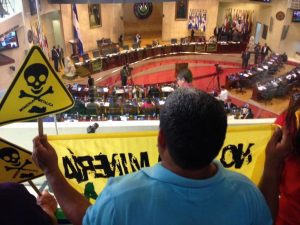Defending Natural Resources, Politics
Bangor Committee Faces Local Mining Threat
Testimony to the Bureau of Environmental Protection re chapter 200 mining regulations 2016
Consider the prospect of an unremitting man-made catastrophe whose damaging effects persist longer than human life spans, or the life of a corporation, longer than the tenure of government administrations, but last for centuries. Though man-made, the damage plays out in geologic time and not human contingency planning time.
One pertinent example of such a disaster would be the specter of metallic mining gone bad in our state. This isn’t scare-mongering. Mining debacles are not things of the past. They are obviously not events that any company will predict would happen, and they occur with some regularity. The last two massive spills were Imperial Metals’ Mt Polley mine August 2014 in British Columbia, the largest tailings pond dam failure in Canadian history, and Samarco’s Bento Rodrigues mine in Mariana, Brazil in November of last year, the largest tailings dam failure ever, anywhere. Both projects were built in full compliance with local law and regulations.

Here in Maine, we are at risk for even more irremediable consequences than from these last two massive, but acute, calamities which were due to breaches in mine tailings storage systems. A mine gone bad at some sites in our state could create a rent in the fabric of Maine’s geology which, once created, could bleed acid mine drainage in perpetuity, like a wound that festers but cannot heal. The drainage could begin during the life of the mine, or decades later, after the demise of the company that operated it. It could last for decades, or for centuries. If by permanent we usually mean “as long we and many generations of our descendants live”, it could contaminate our water quality permanently, and damage Maine’s brand, which is a vital economic resource in Maine’s economy, permanently.
Over the last two years at hearings just like this, we’ve heard a series of distinguished geologists and hydrologists testify that open pit sulfide mining in some parts of our state risks courting precisely this magnitude of slow-motion, long-term disaster. Those professional assessments were based on the unique combination of Maine’s massive acid reactive deposits, the lack of adequate natural neutralizing capacity in the surrounding landmass, our naturally wet environment, and the near certainty of accelerated climate change that will bring, almost predictably, unprecedented extreme weather events.
In the face of a disaster of this scale and duration, the deliberations of legislative committees, environmental bureaus, or courts of law about the appropriate size of reclamation bonds, mitigation strategies, public vs private liabilities, would be rendered beside the point. There will be no fund large enough, and no remediation possible.
Many natural disasters defy prevention or regulation but some man-made disasters may be averted by statute. Unfortunately, our current mining statute is not one of them. We are all laboring under the constraints imposed by LD1853, passed at the 11th hour in 2012* essentially at the behest of the J.D. Irving Company which had its eye on a piece of land it wanted to exploit at Bald Mountain in Aroostook County
Unfortunately, the question addressed by this legislation was essentially, “How can we make mining regulations less onerous to a company that wants to mine?” It was about how to “streamline” permitting, not about asking the hard questions about what Mainers’ risk tolerance should be for long-term environmental damage and public health hazards. Once LD1853 was passed, the rule-making that followed has been framed, and constrained, by the statute’s mandate.
The questions not asked were: What level of environmental, public health and financial risk are we willing to ask Mainers to accept if metallic mining is to be done in Maine? Are there certain mining projects that should never be considered in the first place if that risk is too high? How can we determine what those risks are? Might a Precautionary Principle apply in evaluating these risks and benefits? How can we access the expertise to make these decisions?
A statute that doesn’t ask these questions can’t frame rules that answer them. And until we have such a statute, there is no point in repealing current chapter 200 rules only to debate replacement rules that can’t possibly address the vital issues that metallic mining poses. Referring to public criticisms of the mining regulations, The Bangor Daily News this week quotes DEP Communications David Madore stating that the “Department does not have the ability to fully address these concerns without statutory changes by the Legislature.”
We understand from DEP Communications Director Madore that inconsistencies between the Mining Act and existing rules create numerous ambiguities that would require any mining application to contend with the lack of regulatory certainty provided by detailed rules. We understand that those inconsistencies are the impetus for the DEP’s annual efforts to reconcile statute and rules, even though the department is not mandated to keep submitting rules.
We hear the DEP state that new rules are essential because statute/regulation inconsistencies may actually render our environment more vulnerable. Besides the DEP, we’ve listened to mining advocates make the same argument: Company lawyers could successfully argue, they say, that when push comes to shove, less restrictive statutes will legally trump more restrictive rules.
This may be a technically correct argument, even if a tad disingenuous coming from mining lobbyists. But in fact no mining company will be willing to invest its time and money in what would be a byzantine and legally fraught permitting process. For which reason other metallic mining advocates complain that as it now stands, the 1991 regulations are tantamount to a moratorium on mining.
We agree. At present these statute/rules inconsistencies create in effect, a temporary moratorium on metallic mining in Maine. But lets not conflate a dilemma for mining companies with a crisis for Mainers, in need of immediate remedy. Far worse would be regulations that comport with Maine’s mining law but don’t address the critical questions that LD 1853 never bothered to ask.
You can spare us what has now become an annual exercise of public policy tunnel vision that can’t illuminate the critical mining issues that need resolution.The most constructive public policy action the BEP can undertake is to support our current de facto moratorium, rather than to consign all parties involved to what will feel like yet another episode of mining ground hog day. To do so, all you need do is thank the DEP for its good-faith efforts, and then not precede any further with these rules until Maine has the mining statute it deserves. There’s no rush.
Learn more about the Bangor Sister Cities Committee, which is part of PICA, Power in Communities, at their website
*“About Face: How a Mine Moved Toward Operating in Maine”. Thomas Doyle, Mathew Manahan, Avery T. Day and Pierce Atwood, Dec 2012, Mining Engineering
http://www.pierceatwood.com/webfiles/Mining%20How%20a%20mine%20move%20toward%20opening%20in%20Maine.pdf



